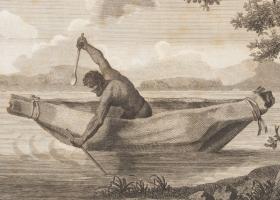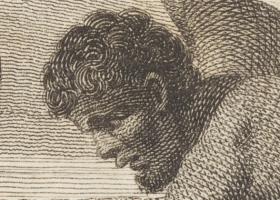War and resistance
Students examine the events leading to Pemulwuy’s role in the war against the colonists.

War and resistance
Despite his early good intentions and attempts at friendship, Governor Arthur Phillip ultimately used guns as threats towards Aboriginal people, he imposed British law when they had their own law, the introduced disease – smallpox - killed about HALF the local Aboriginal population (possibly many many more), he ordered his soldiers to harm and kill Aboriginal people, he instigated the destruction of their land and resources and ultimately displaced them from their own country!
Governor Arthur Phillip knew early on how Aboriginal people felt about the establishment of the colony.
Read what he wrote in September 1788 in a letter to Lord Sydney:
They are certainly not pleased with us remaining amongst them.
Answer these questions:
- Do you think the words not pleased are the words Aboriginal people would use to describe how they felt about the First Fleet settling on their land? Why?
- Can you find other words that you think might fully express their feelings? Look up a thesaurus to help you.
Two years later the situation had not changed.
Read Captain Watkin Tench’s words written in September 1790 about a conversation at Rose Hill between some colonists and a few Aboriginal people:
They…expressed great dissatisfaction at the number of white men who had settled in their former territories.
Define the term great dissatisfaction. Put it into your own words.
Answer these questions:
- If the colonists knew there was great dissatisfaction amongst Aboriginal people, what were they doing about it?
- If you were in charge of the colony, how would you have responded to this?
- If you were an Aboriginal person at this time, would you have considered fighting back?
Pemulwuy
Pemulwuy (pronounced Pem-mull-way) was a Bidjigal man and a powerful Aboriginal resistance leader in the war against the British invaders.
Define the word resistance.
So who was Pemulwuy?
Look at this image of Pemulwuy in a mari nawi and a close-up of his face. It is the only known image of Pemulwuy.


Pemulwuy was born around 1750 on Bidjigal country. Bidjigal country probably spread west from Kamay (Botany Bay) to Salt Pan Creek, a tributary of the Georges River, and up along the river towards Bankstown. Pemulwuy was part of the complex social and cultural world of Sydney’s Aboriginal people. The toes on his left foot had been damaged by a club, and it has been suggested that this meant that Pemulwuy was a carradhy, a healer or wise man.
In December 1790 Pemulwuy fatally speared Governor Phillip’s convict game hunter, John McEntire. This event is part of the very important and complex story of the relationship between colonists and Aboriginal people.
Read Captain Watkin Tench’s record of what happened in December 1790:
A serjeant of marines, with three convicts, among whom was M'Entire, the governor's gamekeeper (the person of whom Baneelon had, on former occasions, shewn so much dread and hatred) went out on a shooting party.
They slept in the bush that night.
About one o'clock, the serjeant was awakened by a rustling noise in the bushes near him, and supposing it to proceed from a kanguroo, called to his comrades, who instantly jumped up. On looking…, they saw two natives, with spears in their hands, creeping towards them, and three others a little farther behind. As this naturally created alarm, M'Entire said, ‘don't be afraid, I know them,’ and immediately laying down his gun, stepped forward, and spoke to them in their own language…M'Entire accompanied them about a hundred yards, talking familiarly all the while. One of them now jumped on a fallen tree, and without giving the least warning of his intention, launched his spear at M'Entire, and lodged it in his left side. The person who committed this wanton act, was described as a young man, with a speck, or blemish, on his left eye; that he had been lately among us, was evident from his being newly shaved. The wounded man immediately drew back, and joining his party, cried, ‘I am a dead man’.
John McEntire was taken to the hospital.
Colbee, and several more natives came in, and were taken to the bed where the wounded man lay. Their behaviour indicated, that they had already heard of the accident, as they repeated twice or thrice the name of the murderer Pim-el- wì, saying, that he lived at Botany Bay… The governor, in order to deter the natives from such practices in future, has ordered out a party to search for the man who wounded the convict M'Entire.
Governor Arthur Phillip asked Bennelong and Colebee to bring Pemulwuy into the settlement with no success, so he decided to send:
A party, consisting of two captains, two subalterns, and forty privates, with a proper number of non-commissioned officers, from the garrison, with three days provisions, &c. are to be ready to march to-morrow morning at day-light, in order to… to bring away two natives as prisoners: and to put to death ten: that we were to destroy all weapons of war, but nothing else: that no hut was to be burned: that all women and children were to remain uninjured.
Governor Arthur Phillip:
was determined to strike a decisive blow, in order, at once to convince them of our superiority, and to infuse an universal terror, which might operate to prevent farther mischief.
John McEntire died a month after being speared. No Aboriginal people were injured or killed during the march to Botany Bay.
[You can read Watkin Tench’s full and long description of this event online, pp 64-72 from his book A Complete Account of the Settlement at Port Jackson.]
Answer these questions:
- Whose perspective are you seeing in this account of the events? Do you think this is the whole story?
- Was the writer of the account actually a witness to the events or reporting another person’s story? Is that reliable?
- What had motivated the attack? Do we know?
- Why did Bennelong feel dread and hatred towards John McEntire? What was John McEntire’s history with Aboriginal people? Do we know?
- Was Pemulwuy working alone?
- Why did Arthur Phillip respond in the way he did? Discuss why you think he chose that pathway.
- Why did Governor Arthur Phillip say he wanted to convince them of our superiority? What does that mean? [Note: This is not an acceptable way to talk about people today.]
- What were the repercussions of the death of John McIntire ,and separately, of Governor Phillip’s response for different groups of people - Aboriginal people, convicts, soldiers, government officials and Governor Arthur Phillip?
- Can you identify any common emotions that may have been felt by EVERYONE?
Some historians suggest that Governor Phillip’s response (ordering the march to Botany Bay to capture and kill Aboriginal people) was just ‘for show’ in order to appease the frightened convicts, and that they were not really going to hurt anyone. Others suggest that Captain Watkin Tench who led the soldiers on their march to Botany Bay and is known for his sympathetic tolerance, might have deliberately not found any Aboriginal people so he did not have to carry out the Governor’s instructions to kill anyone?
Answer these questions:
- Do we know what everyone was thinking at that time?
- Are these suggestions about the march worth considering, or are they just excuses? Discuss.
Life changed after this. Pemulwuy witnessed the spread of the settlement on Aboriginal land, the abduction of Aboriginal women and children and was offended by the lack of respect for all things Aboriginal. He led Aboriginal warriors in attacks, robberies, assaults and raids to defend and fight for what was theirs and to try to move the colonists on.
Interestingly, some convicts had also joined the Aboriginal resistance, so the picture of Aboriginal people versus European people was a little muddied. William Knight and Thomas Thrush were convicts who became active members of the resistance. Some convict servants would also refuse to take part in reprisal raids against Aboriginal people. In 1801 Reverend Samuel Marsden ordered convict servants in Parramatta to join the soldiers in these raids. A convict servant of a man named George Caley refused, as he was friendly with the Aboriginal people of Parramatta. The convict servant was arrested and put in gaol by Reverend Marsden.
Pemulwuy brought together many Aboriginal groups and fought hard to preserve their way of life, their culture and their peoples. Pemulwuy lead the resistance as part of what many people now call the Frontier Wars.
Research the Battle of Parramatta in March 1797. Discuss the reasons it occurred and the fallout.
As a result of the Battle of Parramatta, Pemulwuy was taken to Parramatta hospital with seven buckshot in his body and head. No one expected him to survive. A few days later, he escaped the hospital in irons. Over the next few years Pemulwuy continued to recover from injuries, attacks and reports of being killed. He developed a reputation of having supernatural powers.
Define the word supernatural.
Answer these questions:
- How do you think Aboriginal people felt about Pemulwuy? Did they all feel the same way?
- How do you think the colonists felt about Pemulwuy? Did they all feel the same way?
- What would you do in his situation?
Read how Pemulwuy was described in 1802 by Philip Gidley King (who was Governor at this time) in a letter to Lord Hobart:
an active, daring leader of his people
and he also wrote that:
Altho' a terrible pest to the colony, he was a brave and independent character.
Answer these questions:
- Are there any words in the quotes that you think describe Pemulwuy?
- Do we have a different view of Pemulwuy to the colonists of the time? Why?
These descriptions do not reflect the whole man, his life and exploits. Choose other adjectives to describe Pemulwuy’s life that you would like to read in the history books. Look up a thesaurus to find the best words.
On 22 November 1801, the Governor, Philip Gidley King, issued an order that Pemulwuy, as an outlaw, was to be captured ‘dead or alive’ with the bonus of a reward for the captor/killer. Pemulwuy was killed in June 1802. We don’t know the exact day or where it happened or even the precise events leading up to it.
Terribly, after his death, Pemulwuy’s head was severed from his body and shipped to Joseph Banks in England.
Answer this question:
- Was the death of Pemulwuy the end of the war? Discuss.
Compare these two men, Pemulwuy, b. 1750-1802 and Bennelong, b.1764-1813 (from Activity 2). These two proud Aboriginal men who lived during the same era of history made very different choices in their dealings with the colonists. Discuss and compare the outcomes of their choices for both Aboriginal people and the colonists. Consider their motivation and the qualities they did or did not have in common.